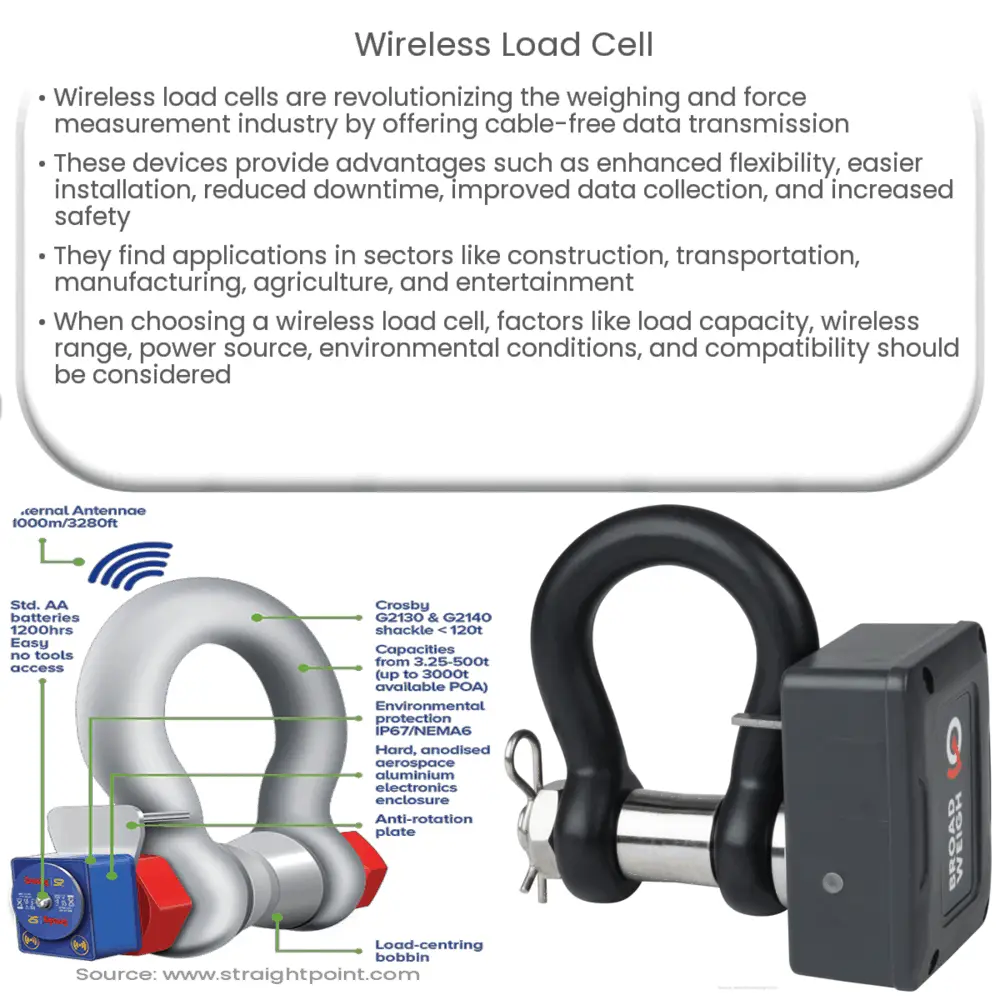Wireless load cells revolutionize weighing & force measurement with increased flexibility, safety, and real-time data collection across various industries.

Wireless Load Cell: Revolutionizing the Weighing Industry
As the world becomes more connected, technological advancements are changing the way we operate in various industries. One such innovation is the wireless load cell, a device that is revolutionizing the weighing and force measurement sector. In this article, we will explore what a wireless load cell is, its advantages, and its applications across various industries.
What is a Wireless Load Cell?
A load cell is a transducer that converts force or pressure into an electrical signal. The force applied to the load cell results in a deformation of its structure, which in turn changes the electrical resistance of strain gauges placed within the device. This change in resistance is proportional to the force applied and can be accurately measured to provide precise readings.
Traditional load cells have always required a wired connection to transmit the electrical signal to an external device for processing and displaying the weight or force measurement. However, wireless load cells eliminate the need for these wired connections by incorporating wireless transmission technology, such as Bluetooth, Wi-Fi, or proprietary wireless protocols, to send the signal directly to a remote device. This makes the wireless load cell a more versatile, reliable, and efficient tool for various applications.
Advantages of Wireless Load Cells
There are several advantages to using wireless load cells over their wired counterparts, including:
- Increased Flexibility: The absence of cables allows for more flexibility in the placement of load cells in challenging environments, where wired connections could be impractical or impossible.
- Easier Installation: Installing wireless load cells is often quicker and less labor-intensive, as there is no need to route cables or install cable management systems.
- Reduced Downtime: Wireless load cells reduce the risk of downtime caused by cable damage, which can occur due to wear and tear or accidental cutting during operations.
- Enhanced Data Collection: The wireless transmission of data allows for real-time monitoring and data logging, making it easier to analyze trends and optimize processes.
- Improved Safety: By eliminating the need for physical connections, wireless load cells reduce the risk of accidents caused by tripping over cables or electrical hazards.
Applications of Wireless Load Cells
Wireless load cells have a wide range of applications across various industries, such as:
- Construction: In the construction industry, wireless load cells are used to measure the weight of materials and equipment during lifting operations, ensuring safe and efficient processes.
- Transportation: In the transportation sector, wireless load cells help measure the weight of vehicles and cargo to ensure they are within regulatory limits and prevent overloading.
- Manufacturing: Wireless load cells play a crucial role in measuring and controlling force during manufacturing processes, such as assembly, tensioning, and torque control.
- Agriculture: In the agricultural sector, wireless load cells are utilized to accurately measure the weight of crops, livestock, and feed, allowing farmers to optimize yield and manage resources more effectively.
- Oil and Gas: The oil and gas industry uses wireless load cells for monitoring the weight of drilling equipment and pipeline components to ensure safe operations and prevent equipment damage.
- Entertainment: In the entertainment industry, wireless load cells are used to safely rig stage equipment and monitor the loads on structures, ensuring the safety of performers and audience members.
- Research and Development: In R&D settings, wireless load cells are employed to measure forces and weights in various testing environments, from automotive crash tests to aerospace component stress testing.
Choosing the Right Wireless Load Cell
With the numerous advantages and applications of wireless load cells, it’s essential to choose the right device for your specific needs. Here are some factors to consider when selecting a wireless load cell:
- Load Capacity: Choose a wireless load cell with an appropriate load capacity for your application, ensuring accurate and reliable measurements without overloading the device.
- Wireless Range: Consider the wireless transmission range of the load cell and ensure it’s sufficient for your operational environment. Depending on the technology used, wireless ranges can vary significantly.
- Power Source: Evaluate the power source of the wireless load cell, such as batteries or energy harvesting, and consider the implications for battery life, maintenance, and environmental impact.
- Environmental Conditions: Assess the operating conditions of your application and choose a wireless load cell designed to withstand those specific conditions, such as temperature, humidity, and potential exposure to chemicals or contaminants.
- Compatibility: Ensure the wireless load cell is compatible with your existing data collection and display equipment, or consider investing in compatible devices to optimize your system.
- Cost: Finally, weigh the costs and benefits of various wireless load cell options to make an informed decision that balances performance, reliability, and affordability.
Conclusion
Wireless load cells are a groundbreaking innovation that is transforming the weighing and force measurement industry. By offering increased flexibility, easier installation, reduced downtime, enhanced data collection, and improved safety, these devices are becoming an essential tool in a wide range of applications. By carefully considering your unique needs and selecting the right wireless load cell, you can enjoy the benefits of this advanced technology and optimize your operations for maximum efficiency and safety.

